Input interpretation

lead (chemical element) | indium (chemical element) | tin (chemical element)
Periodic table location
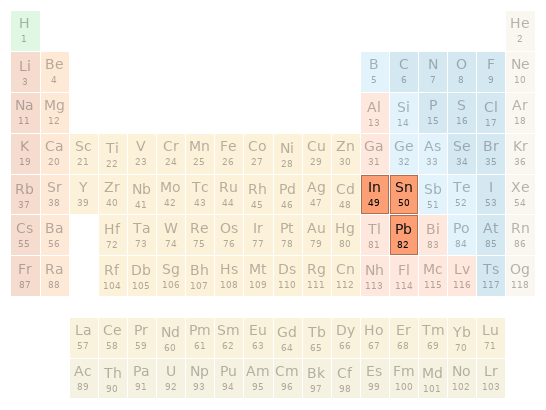
Periodic table location
Images
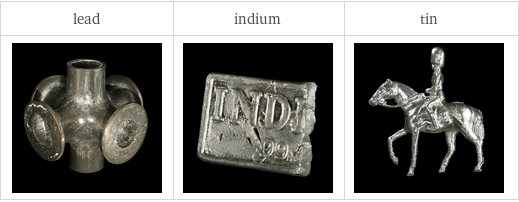
Images
Basic elemental properties
![| lead | indium | tin atomic symbol | Pb | In | Sn atomic number | 82 | 49 | 50 short electronic configuration | [Xe]6s^24f^145d^106p^2 | [Kr]5s^24d^105p^1 | [Kr]5s^24d^105p^2 Aufbau diagram | 6p 5d 4f 6s | 5p 4d 5s | 5p 4d 5s block | p | p | p group | 14 | 13 | 14 period | 6 | 5 | 5 atomic mass | 207.2 u | 114.818 u | 118.71 u half-life | (stable) | (stable) | (stable)](../image_source/7a8c03c9e5f661cc8c0a2577c61453b5.png)
| lead | indium | tin atomic symbol | Pb | In | Sn atomic number | 82 | 49 | 50 short electronic configuration | [Xe]6s^24f^145d^106p^2 | [Kr]5s^24d^105p^1 | [Kr]5s^24d^105p^2 Aufbau diagram | 6p 5d 4f 6s | 5p 4d 5s | 5p 4d 5s block | p | p | p group | 14 | 13 | 14 period | 6 | 5 | 5 atomic mass | 207.2 u | 114.818 u | 118.71 u half-life | (stable) | (stable) | (stable)
Thermodynamic properties

| lead | indium | tin phase at STP | solid | solid | solid melting point | 327.46 °C | 156.6 °C | 231.93 °C boiling point | 1749 °C | 2072 °C | 2602 °C molar heat of fusion | 4.77 kJ/mol | 3.26 kJ/mol | 7 kJ/mol molar heat of vaporization | 178 kJ/mol | 230 kJ/mol | 290 kJ/mol specific heat at STP | 127 J/(kg K) | 233 J/(kg K) | 217 J/(kg K) (properties at standard conditions)
Material properties

| lead | indium | tin density | 11.34 g/cm^3 | 7.31 g/cm^3 | 7.31 g/cm^3 liquid density | 10.66 g/cm^3 | 7.02 g/cm^3 | 6.99 g/cm^3 molar volume | 18.27 cm^3/mol | 15.71 cm^3/mol | 16.24 cm^3/mol Mohs hardness | 1.5 (between talc and gypsum) | 1.2 (between talc and gypsum) | 1.5 (between talc and gypsum) Brinell hardness | 38.3 MPa | 8.83 MPa | 51 MPa bulk modulus | 46 GPa | | 58 GPa shear modulus | 5.6 GPa | | 18 GPa Young's modulus | 16 GPa | 11 GPa | 50 GPa Poisson ratio | 0.44 | | 0.36 ultimate tensile strength | 18 MPa | 4 MPa | 220 MPa sound speed | 1260 m/s | 1215 m/s | 2500 m/s thermal expansion | 2.89×10^-5 K^(-1) | 3.21×10^-5 K^(-1) | 2.2×10^-5 K^(-1) thermal conductivity | 35 W/(m K) | 82 W/(m K) | 67 W/(m K) (properties at standard conditions)
Electromagnetic properties
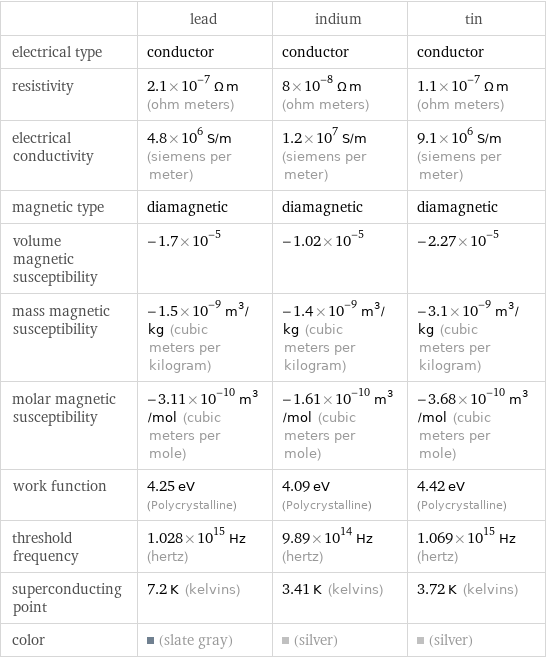
| lead | indium | tin electrical type | conductor | conductor | conductor resistivity | 2.1×10^-7 Ω m (ohm meters) | 8×10^-8 Ω m (ohm meters) | 1.1×10^-7 Ω m (ohm meters) electrical conductivity | 4.8×10^6 S/m (siemens per meter) | 1.2×10^7 S/m (siemens per meter) | 9.1×10^6 S/m (siemens per meter) magnetic type | diamagnetic | diamagnetic | diamagnetic volume magnetic susceptibility | -1.7×10^-5 | -1.02×10^-5 | -2.27×10^-5 mass magnetic susceptibility | -1.5×10^-9 m^3/kg (cubic meters per kilogram) | -1.4×10^-9 m^3/kg (cubic meters per kilogram) | -3.1×10^-9 m^3/kg (cubic meters per kilogram) molar magnetic susceptibility | -3.11×10^-10 m^3/mol (cubic meters per mole) | -1.61×10^-10 m^3/mol (cubic meters per mole) | -3.68×10^-10 m^3/mol (cubic meters per mole) work function | 4.25 eV (Polycrystalline) | 4.09 eV (Polycrystalline) | 4.42 eV (Polycrystalline) threshold frequency | 1.028×10^15 Hz (hertz) | 9.89×10^14 Hz (hertz) | 1.069×10^15 Hz (hertz) superconducting point | 7.2 K (kelvins) | 3.41 K (kelvins) | 3.72 K (kelvins) color | (slate gray) | (silver) | (silver)
Reactivity
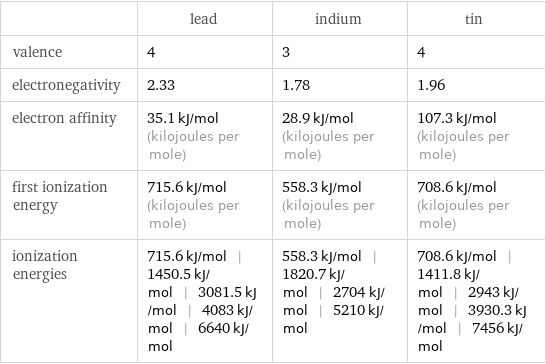
| lead | indium | tin valence | 4 | 3 | 4 electronegativity | 2.33 | 1.78 | 1.96 electron affinity | 35.1 kJ/mol (kilojoules per mole) | 28.9 kJ/mol (kilojoules per mole) | 107.3 kJ/mol (kilojoules per mole) first ionization energy | 715.6 kJ/mol (kilojoules per mole) | 558.3 kJ/mol (kilojoules per mole) | 708.6 kJ/mol (kilojoules per mole) ionization energies | 715.6 kJ/mol | 1450.5 kJ/mol | 3081.5 kJ/mol | 4083 kJ/mol | 6640 kJ/mol | 558.3 kJ/mol | 1820.7 kJ/mol | 2704 kJ/mol | 5210 kJ/mol | 708.6 kJ/mol | 1411.8 kJ/mol | 2943 kJ/mol | 3930.3 kJ/mol | 7456 kJ/mol
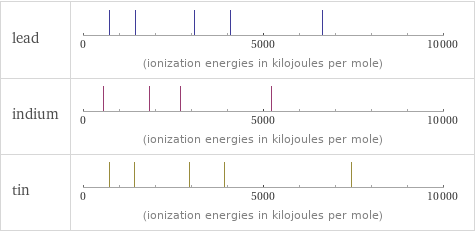
Reactivity
Atomic properties

| lead | indium | tin term symbol | ^3P_0 | ^2P_(1/2) | ^3P_0 atomic radius | 180 pm | 155 pm | 145 pm covalent radius | 146 pm | 142 pm | 139 pm van der Waals radius | 202 pm | 193 pm | 217 pm (electronic ground state properties)
Abundances
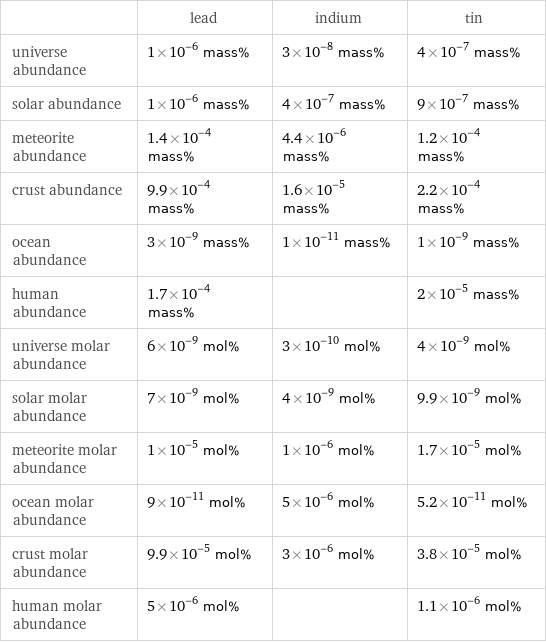
| lead | indium | tin universe abundance | 1×10^-6 mass% | 3×10^-8 mass% | 4×10^-7 mass% solar abundance | 1×10^-6 mass% | 4×10^-7 mass% | 9×10^-7 mass% meteorite abundance | 1.4×10^-4 mass% | 4.4×10^-6 mass% | 1.2×10^-4 mass% crust abundance | 9.9×10^-4 mass% | 1.6×10^-5 mass% | 2.2×10^-4 mass% ocean abundance | 3×10^-9 mass% | 1×10^-11 mass% | 1×10^-9 mass% human abundance | 1.7×10^-4 mass% | | 2×10^-5 mass% universe molar abundance | 6×10^-9 mol% | 3×10^-10 mol% | 4×10^-9 mol% solar molar abundance | 7×10^-9 mol% | 4×10^-9 mol% | 9.9×10^-9 mol% meteorite molar abundance | 1×10^-5 mol% | 1×10^-6 mol% | 1.7×10^-5 mol% ocean molar abundance | 9×10^-11 mol% | 5×10^-6 mol% | 5.2×10^-11 mol% crust molar abundance | 9.9×10^-5 mol% | 3×10^-6 mol% | 3.8×10^-5 mol% human molar abundance | 5×10^-6 mol% | | 1.1×10^-6 mol%
Nuclear properties

| lead | indium | tin half-life | (stable) | (stable) | (stable) stable isotopes | Pb-208 (52.4%) | ... | In-113 (4.29%) | Sn-120 (32.58%) | ... unstable isotopes | Pb-205 (17.3 Myr) | ... | In-115 (441 trillion yr) | ... | Sn-126 (0.23 Myr) | ...
Units
